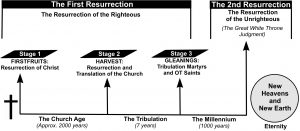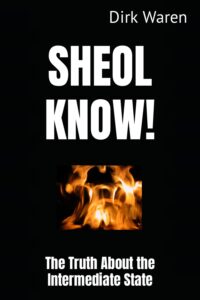RESURRECTIONS: Firstfruits, Harvest & Gleanings
Whether believers know it or not, the resurrection of the dead is one of The Six Basic Doctrines of Christianity, as shown in Hebrews 6:1-2. Unfortunately, it’s rarely taught and so the body of Christ is largely ignorant on the topic. This article will help rectify the problem.
The Bible speaks of two types of resurrections…
The Resurrections of the Righteous and the Unrighteous
Jesus and Paul plainly declared two basic resurrections:
“for a time is coming when all who are in their graves will hear his voice (29) and come out—those who have done what is good will rise to live, and those who have done what is evil will rise to be condemned.”
John 5:28-29
having hope toward God, which they themselves also wait for, that there is about to be a rising again of the dead, both of righteous and unrighteous;
Acts 24:15 (YLT)
As you can see, there will be resurrections of both the righteous and unrighteous. This doesn’t mean, however, that there will only be two resurrections in number, just that there are two types of resurrections: 1. The resurrection of the righteous and 2. the resurrection of the unrighteous. The former is called “first resurrection” in Scripture (Revelation 20:5-6), which makes the latter the second resurrection.
The second resurrection takes place at the time of the Great White Throne Judgment, detailed here:
Then I saw a great white throne and him who was seated on it. The earth and the heavens fled from his presence, and there was no place for them. (12) And I saw the dead, great and small, standing before the throne, and books were opened. Another book was opened, which is the book of life. The dead were judged according to what they had done as recorded in the books. (13) The sea gave up the dead that were in it, and death and Hades gave up the dead that were in them, and each person was judged according to what they had done. (14) Then death and Hades were thrown into the lake of fire. The lake of fire is the second death. (15) Anyone whose name was not found written in the book of life was thrown into the lake of fire.
Revelation 20:11-15
This massive judgment concerns every dead soul contained in Hades (Sheol) after the thousand-year reign of Christ on this earth, which means it involves every unredeemed person throughout history. It does not include Old Testament holy people because they had a covenant with the LORD and will be resurrected after the 7-year Tribulation and before the Millennium, which we’ll examine later this chapter.
The second resurrection is covered in this article; or pick up my book HELL KNOW, for even more details. Both examine the nature of the “second death”—i.e. being thrown into the lake of fire (verses 14-15), but the latter also explores the question of whether or not every person who partakes of this resurrection will automatically be cast into the lake of fire. For instance, what about those who never heard the gospel? What about those who heard the gospel but didn’t understand it for one legitimate reason or another? What about those who rejected it because it was either a flawed, religionized version of the gospel or it came with serious baggage, like imperialism? Every legitimate minister of God’s Word must consider these obvious questions and try to answer them based on what the Bible says and simple common sense. I would be seriously skeptical of anyone who doesn’t do this, particularly those who write off such questions in preference to the official position of whatever group they adhere to, which is an example of rigid sectarianism. Staunch sectarianism actually hinders the truth and, in fact, is a form of legalism, i.e. counterfeit Christianity. Remember, Jesus said it’s the truth that will set us free (John 8:31-32), so anything that hinders the acquisition of truth is not good.
You can read more about this here (Scroll down to the sections on Post-Mortem Evangelization and Inclusivism and Restrictivism).
The Resurrection of the Righteous
The first resurrection is the resurrection of the righteous, meaning those in right-standing with God. Again, when Jesus and Paul spoke of two basic resurrections they were talking about types of resurrections and not numbers. While there’s only one resurrection of the unrighteous, the resurrection of the righteous takes place in stages, which correspond to the analogy of a harvest.
In biblical times the harvest took place in three basic stages: 1. the firstfruits, 2. the main harvest, and 3. the gleanings. The harvest began with the firstfruits, which concerned the first fruits and grains to ripen in the season and were offered to the LORD as a sacrifice of thanksgiving (Exodus 23:16,19). Later came the general harvest (Exodus 23:16) and, lastly, the gleanings, which were leftovers for the poor and needy (Leviticus 19:9-10).
Let’s examine the three stages:
1. The Firstfruits. Paul described Jesus as the firstfruits here:
But Christ has indeed been raised from the dead, the firstfruits of those who have fallen asleep. (21) For since death came through a man, the resurrection of the dead comes also through a man. (22) For as in Adam all die, so in Christ all will be made alive. (23) But each in turn: Christ, the firstfruits; then, when he comes, those who belong to him.
1 Corinthians 15:21-23
Just as the firstfruits of the harvest were a sacrifice to the LORD so Jesus Christ was sacrificed for our sins and raised to life for our justification (Romans 4:25); hence, he’s the firstfruits of the resurrection of the righteous.
2. The General Harvest. Verse 23 shows that the main harvest takes place when Jesus returns for the church—his “bride”—which is the Rapture, detailed in 1 Thessalonians 4:13-18. This harvest includes physically-alive believers translated to heaven.
3. The Gleanings refer to the righteous who were not included in the main harvest and are, as such, “leftovers.” This resurrection takes place at the time of Jesus’ return at the end of the Tribulation. Jesus’ return to earth to establish his millennial reign is separate from the Rapture, which is when the general harvest occurs. Remember, when Jesus comes for his church he doesn’t return to earth, but rather meets believers in the sky (1 Thessalonians 4:17). We’ll address this in a forthcoming section. The gleanings include the resurrection of Old Testament saints—at least a bodily resurrection, but more likely a soulish/bodily resurrection (more on this later)—as well as the bodily resurrection of believers who died during the Tribulation.
The “gleanings” will also include believers who physically die during the Millennium. Some argue that such a resurrection won’t be necessary because, as Isaiah 65:19-25 shows, lifespans will return to the lengthy durations of people before the flood, like Adam and Methuselah. However, this passage doesn’t actually say righteous people won’t die during the Millennium; notice what it says:
Never again will there be in it [Jerusalem] an infant who lives but a few days, or an old man who does not live out his years; the one who dies at a hundred will be thought a mere child; the one who fails to reach a hundred will be considered accursed.
Isaiah 65:20
The passage simply shows that lifespans will be greatly increased, as before the flood; it doesn’t say righteous people won’t die. In fact, it’s implied that blessed people will die by the reference to “an old man who does not live out his years.” Moreover, verse 22 says that God’s people will live as long as trees during the Millennium. Depending on the species, trees can live less than a hundred years or up to a few thousand, but they ultimately die.
Something else to consider: While it’s true that many people lived to be over 900 years old before the flood, it’s still not a thousand years, which is how long the Millennium will last. Also, some people died well short of 900-plus years; for instance, Lamech died at 777.
Someone might argue: How can both the resurrection of the righteous at the beginning of the Millennium and another resurrection at the end be considered “gleanings” since they’re separated by a thousand years? Answer: Because the very word “gleanings” implies more than one gleaning; after all, the poor gleaned the harvested fields more than once in biblical times. Also, Psalm 90:4 and 2 Peter 3:8 show that a thousand years is like a day to the LORD, so the two gleanings occur only one day apart from the Divine perspective.
Why is it Called the “First Resurrection”?
The resurrection of the righteous is called the “first resurrection” in this passage:
I saw thrones on which were seated those who had been given authority to judge. And I saw the souls of those who had been beheaded because of their testimony about Jesus and because of the word of God. They had not worshiped the beast or its image and had not received its mark on their foreheads or their hands. They came to life and reigned with Christ a thousand years. (5) (The rest of the dead did not come to life until the thousand years were ended.) This is the first resurrection. (6) Blessed and holy are those who share in the first resurrection. The second death has no power over them, but they will be priests of God and of Christ and will reign with him for a thousand years.
Revelation 20:4-6
The passage refers specifically to the bodily resurrection of Christian martyrs from the Tribulation, which John calls the “first resurrection.” By calling it the first resurrection is he saying that there were no resurrections before this? No, because Jesus Christ was resurrected at the beginning of the Church Age and believers will be resurrected bodily at the time of the Rapture while living believers will be translated; not to mention the resurrections of Enoch, Elijah and Moses as types, covered in Chapter Nine of SHEOL KNOW. Speaking of those three, their resurrections can be considered “taste-testing of the fruit” according to the harvest analogy.
Here’s a diagram that helps visualize the first and second resurrections and the three stages of the first:
(Click for enlargement and clarity)
By calling the resurrection of the righteous the “first resurrection” John may mean more than just first in order. The Greek word for “first” is prótos (PRO-toss), which also means principle, chief, honorable or most important. How is the resurrection of the righteous the more honorable resurrection? Because it entails the resurrection of people in right-standing with the LORD through covenant and spiritual rebirth (Titus 3:5 & Ephesians 4:22-24). Since this resurrection involves people who are in right-standing with their Creator, i.e. God’s children, it’s the more honorable resurrection and therefore the more important one to the LORD, just as the resurrection of your child would be more important to you than some stranger you never knew.
Someone might argue that all people are God’s children, even atheists. No, all people are creations of God, but only those born-again of the seed (sperm) of Jesus Christ by the Holy Spirit are children of God (1 John 3:9). Because of the death and resurrection of the Messiah, Old Testament saints who were in covenant with God automatically become spiritually-regenerated at the time of their resurrection.
‘Isn’t this too Complicated?’
Some might argue that the resurrection of the righteous, as mapped out in this chapter, is too complicated. This is perhaps one of the main reasons why the so-called “father of orthodoxy,” Augustine of Hippo, simplified human eschatology by inventing (or, at least, popularizing) the false doctrine of amillennialism. Believe it or not, this erroneous teaching suggests that we’re currently already in both the Millennium and Tribulation; and when believers or unbelievers die their immortal souls either go to heaven forever or suffer never-ending torment in hell. Incredibly, Augustine argued that biblical references to the new Jerusalem, new earth, new heavens and the believer’s new glorified body are all symbolic language for heaven! Talk about adding to and taking away from the Holy Scriptures, a practice repeatedly denounced in the Bible (see Revelation 22:18-19, Proverbs 30:6 and Deuteronomy 4:2).*
* See HELL KNOW for more information on Augustine and his false doctrines that corrupted the church, specifically Chapter Seven’s The Augustinian Corruption of Christendom and Chapter Nine’s The Good and Bad of Orthodoxy and Traditionalism.
Getting back to our question: Is the resurrection of the dead too complicated? Think about it like this: When referencing a complex subject to someone who knows little about the topic it’s best to state the facts in the simplest of terms, which is how Jesus and Paul talked about the resurrection of the dead in John 5:28-29 and Acts 24:15 (both cited at the beginning of this chapter). Daniel did the same thing in Daniel 12:1-2. All three of these passages detail that there will be a resurrection of both the righteous and the unrighteous, which is true, but they don’t go any further than this. As such, we have to look to the rest of Scripture for more details and that’s what we’re doing in this chapter. This is in line with the hermeneutical rule “Scripture interprets Scripture” wherein the more clear and detailed passages offer necessary data that helps interpret the more ambiguous and sketchy ones.
Furthermore, the argument that “this is just too complicated” implies that truth—reality—must always be simple when this simply isn’t the case. Take brain surgery, for example. Is it simple or does it take years of schooling to master? How about computer technology, astronomy, world history, languages or law? How simple is the sewage system of any major city? How about the electrical grid of New York City? I could go on and on.
Yes, the resurrection of the dead is more complicated than what Augustine taught, but it’s certainly not too complicated for the average person to grasp. The above diagram illustrates that it’s actually not that complicated and it’s much less complicated than any of the topics just listed.
As noted at the beginning of this chapter, the resurrection of the dead is one of the six basic doctrines:
Therefore let us move beyond the elementary teachings about Christ and be taken forward to maturity, not laying again the foundation of repentance from acts that lead to death, and of faith in God, (2) instruction about baptisms, the laying on of hands, the resurrection of the dead, and eternal judgment.
Hebrews 6:1-2
Years ago I did a six-part series on these foundational doctrines, one sermon per each doctrine. A knowledgeable minister could easily do a series of teachings on every one of them. Unbelievably, in most Christian camps the six basic doctrines are almost utterly ignored. And then ministers wonder why many in their congregations act like spiritual babies. It’s because the pastors and teachers aren’t properly feeding them! This, by the way, explains the existence and mission of my ministry, Fountain of Life—to feed the body of Christ the rightly-divided Word of God; and to do this free of the constraints (hindrances, limitations) of rigid sectarianism (Matthew 4:4).
In any case, the writer of Hebrews was lamenting that the people he was addressing needed to be taught these basic doctrines all over again when they should’ve been teachers by this point (Hebrews 5:11-12). Now, think about it, if the topic of the resurrection of the dead was as simple as Augustine taught—that is, people just go to heaven or hell when they die to spend eternity in either bliss or torment—why would these people need to be taught the subject again? If the subject were that simplistic it’d take just a few minutes to teach and not a whole sermon or series of sermons. Moreover, if it were that simple how could the believers not grasp it the first time around?
Yes, the resurrection of the dead is sort of a complicated subject and that’s why this article exists.
This article was edited from chapter 11 of…
Print version eBook version
- The print book is available here for just over $10 (257 pages)
- The eBook is available here for just 99¢
- The more affordable Condensed Version is available here for only about $6 (153 pages); or get the eBook for just 99¢.
Related Topics:
Second Coming of Christ — Rapture and Return to Earth
Millennial Reign of Christ — Why?
Universalism, Inclusivism, Restrictivism, Purgatory and the Judgment Seat of Christ
Judgment Seat of Christ (the Judgment of Believers)
The Six Basic Doctrines of Christianity
Is Christ’s Body after Resurrection Physical or Spiritual (or Both)?
comments powered by Disqus







